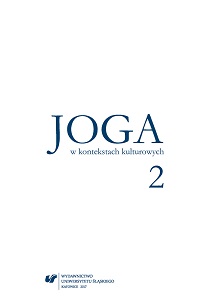Joga klasyczna a joga posturalna – czy coś je łączy?
Classical yoga and postural yoga – are they linked in any way?
Author(s): Natalia Stala
Subject(s): Social Sciences, Fine Arts / Performing Arts, Sociology, Health and medicine and law
Published by: Wydawnictwo Uniwersytetu Śląskiego
Keywords: classical yoga; hathayoga; postural yoga; asana; samadhi; liberation
Summary/Abstract: The famous commentator of the Yogasutras, Vyasa, compared this treatise to a medical manual which describes a disease (involvement in the wheel of birth and death i.e. the samsara), the cause of this disease (a cognitive error consisting in the failure to perceivethe actual self, the purusha), the state of one’s health (absolute freedom, kaivalya), which may be attained already during a yogin’s lifetime, and the remedy against this disease (yoganga). Therefore at the heart of yoga there lies the assumption that it is a practice which is a remedy, it has its therapeutical application. However, when we discuss yoga, we must take into consideration the notion that it is a radical therapy which causes a complete disappearance of suffering, which is equivalent to liberation from the bounds of the wheel of birth and death. The article discusses the problems associated with the reception of yoga in the West, with its deformation and departure from a radical therapy toward a therapy of the body and the mind. The author makes reference to a researcher of this problem, Mark Singleton, who performs an in-depth analysis of the process of the development of new trends in yoga. He claims that the only common element which links classical yoga with modern varieties of yoga (he refers to them as instances of “postural yoga”) is the use of the term “yoga”.The great tree of yoga consists of many branches. One of such branches is hathayoga, which developed by assuming the form of modern postural yoga. It refers to Patanjali’s teachings, but if we examine it closer, it turns out that it constitutes a system which departed considerably from the teachings of its supposed originator. Patanjali emphasized primarily meditation; the most important practice was constituted by sanyama i.e. the three last parts of yoga: dharana, dhyana and samadhi. The modern trends in postural yoga emphasise above all asana, thus making yoga a particular form of gymnastics. The emergence of postural yoga is associated with the influence of tantric hathayoga which revived in the 19th century, and with the gymnastics and body building practices which were fashionable in the West and in India at that time. However, postural yoga is not an esoteric practice which requires initiation. Moreover, the relation with the teacher is irrelevant.
Book: Joga w kontekstach kulturowych 2
- Page Range: 37-49
- Page Count: 13
- Publication Year: 2017
- Language: Polish
- Content File-PDF

